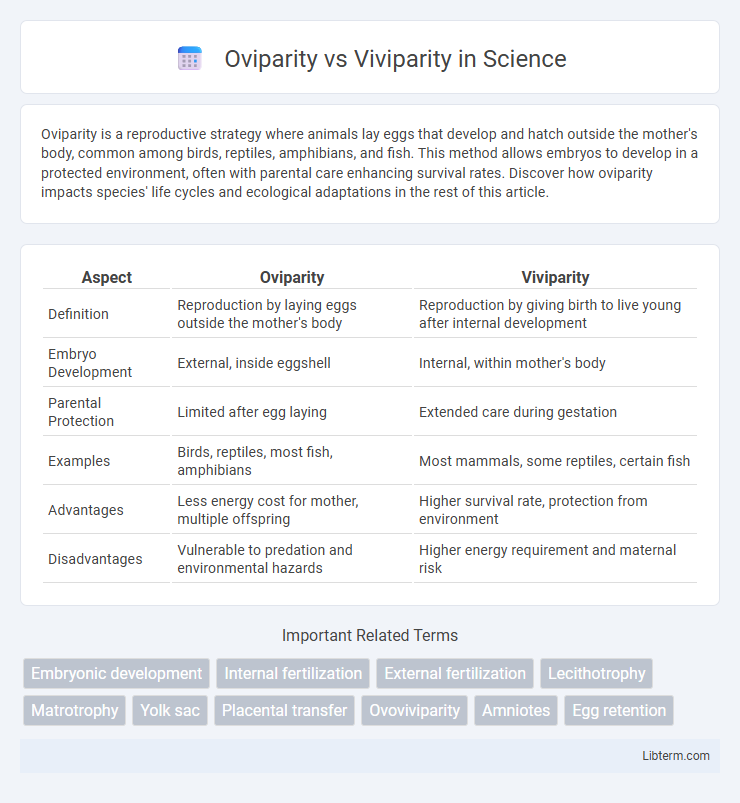Oviparity is a reproductive strategy where animals lay eggs that develop and hatch outside the mother's body, common among birds, reptiles, amphibians, and fish. This method allows embryos to develop in a protected environment, often with parental care enhancing survival rates. Discover how oviparity impacts species' life cycles and ecological adaptations in the rest of this article.
Table of Comparison
| Aspect | Oviparity | Viviparity |
|---|---|---|
| Definition | Reproduction by laying eggs outside the mother's body | Reproduction by giving birth to live young after internal development |
| Embryo Development | External, inside eggshell | Internal, within mother's body |
| Parental Protection | Limited after egg laying | Extended care during gestation |
| Examples | Birds, reptiles, most fish, amphibians | Most mammals, some reptiles, certain fish |
| Advantages | Less energy cost for mother, multiple offspring | Higher survival rate, protection from environment |
| Disadvantages | Vulnerable to predation and environmental hazards | Higher energy requirement and maternal risk |
Introduction to Reproductive Strategies
Oviparity is a reproductive strategy where organisms lay eggs that develop and hatch outside the mother's body, commonly seen in birds, reptiles, and amphibians. Viviparity involves live birth, with embryos developing inside the mother's body, allowing direct nourishment through structures like the placenta in mammals. These contrasting strategies reflect evolutionary adaptations to environmental conditions, offspring survival rates, and parental investment.
Defining Oviparity
Oviparity is a reproductive strategy in which animals lay eggs that develop and hatch outside the mother's body, allowing embryos to obtain nutrients from the yolk. This mode of reproduction is common among birds, reptiles, amphibians, and many fish species. The external development of embryos characteristic of oviparity contrasts with viviparity, where offspring develop inside the mother's body and receive direct nourishment.
Understanding Viviparity
Viviparity is a reproductive strategy in which embryos develop inside the mother's body, receiving direct nourishment until birth, enhancing offspring survival in stable environments. This contrasts with oviparity, where eggs are laid externally, relying on yolk for nutrition. In viviparous species such as mammals, some reptiles, and certain fish, internal gestation allows for more controlled developmental conditions and protection from predators.
Key Differences Between Oviparity and Viviparity
Oviparity involves animals laying eggs that develop and hatch outside the mother's body, while viviparity entails embryos developing inside the mother with live birth. Oviparous species, such as birds and most reptiles, rely on external incubation, whereas viviparous species, including mammals and some reptiles, provide direct nourishment to the developing fetus through a placenta. The key difference lies in embryo development location and maternal investment during gestation, influencing reproductive strategies and offspring survival rates.
Evolutionary Origins and Adaptations
Oviparity and viviparity represent distinct reproductive strategies with evolutionary origins traced back to early vertebrates, where oviparity is considered the ancestral mode characterized by egg-laying and external embryonic development. Viviparity evolved through multiple independent events, marked by internal fertilization and embryonic development within the mother, providing adaptive advantages such as enhanced offspring survival in variable or harsh environments. These adaptations include physiological changes like placenta formation, improved nutrient transfer, and protective mechanisms against predation and environmental stressors, reflecting divergent evolutionary pressures shaping reproductive success.
Advantages of Oviparous Reproduction
Oviparous reproduction offers advantages such as increased offspring quantity due to external egg laying, which reduces maternal energy investment per individual. Eggs can be laid in diverse environments, enhancing species dispersal and survival in varying ecological niches. This method allows quicker generational turnover, supporting faster population growth and adaptation.
Benefits of Viviparous Reproduction
Viviparous reproduction offers enhanced offspring survival through internal development, providing protection from environmental hazards and predators. Nutrient exchange between mother and embryo enables sustained growth, resulting in more developed and viable young at birth. This reproductive strategy supports complex parental investment, increasing the likelihood of offspring reaching maturity in diverse habitats.
Examples of Oviparous and Viviparous Animals
Oviparous animals, such as chickens, turtles, and most fish, lay eggs that develop and hatch outside the mother's body, relying on external conditions for incubation. Viviparous animals, including mammals like humans, whales, and kangaroos, give birth to live young after internal development within the female's uterus. Some species, like certain sharks and snakes, exhibit intermediate reproductive strategies such as ovoviviparity, where eggs hatch inside the mother before birth.
Environmental Influences on Reproductive Modes
Environmental factors play a crucial role in determining reproductive modes such as oviparity and viviparity. Species in colder or unpredictable climates often favor viviparity, allowing internal development to protect embryos from harsh external conditions. Conversely, oviparity is common in stable, warmer environments where external eggs have higher survival rates and resource allocation benefits the species' reproductive success.
Future Perspectives and Scientific Research
Emerging research in reproductive biology increasingly explores genetic and environmental factors influencing oviparity and viviparity, aiming to clarify evolutionary mechanisms that enable transitions between these reproductive modes. Advanced genomic and developmental studies are identifying key regulatory pathways that could unlock new insights into maternal investment strategies and embryonic development. Future perspectives include potential applications in conservation biology and biomedical sciences by manipulating reproductive strategies to enhance species resilience and reproductive health.
Oviparity Infographic

 libterm.com
libterm.com